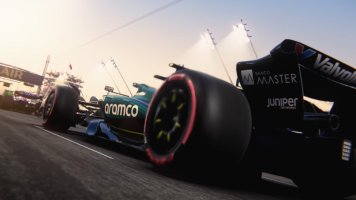Can you show an example or drawing of said bracket? I would like to assemble something that would make it mountable to the seat. I don't mind drilling the shell.
A small metal bracket/hinge but one that allows the angle to be adjusted and also then a surface plate attached that's big enough for the diameter for the exciter. I think the person would need to buy or try various options to see what was best solution but something using this method could be done.
Up for a build challenge?
If however, you are up to a challenge and want to consider an alternative solution that follows what I did with my own tubing. I shared here long ago options for those using 8020 builds.
Let's assume the user is going to attach 1x large BK but wants multiple exciters on the seat.
They want good stereo and body coverage. So as mentioned in many responses, we use the large BK to form a role like a subwoofer handling low bass extension for the desired effects we want to use low bass on.
Exciters are then making contact on the seat for specific body regions and these can have their own effect layers using more the mid-higher bass frequencies. We use Simhub effect layers to represent low bass layers for the sub and then also mid-higher bass layers for the exciters operations. This lets you create effects with a much lower "fundamental frequency" and then apply "harmonically matched" frequencies (multiples) of that "fundamental frequency" being used. It is a much more "natural" way of making effects represent how audio works with harmonics.
I might be repeating myself (yet again) but what you achieve is:
- 1Hz - 200Hz bass response with combined BK/Exciters
- Multi-bodyzone direct vibration
- Less workload on individual units
- Controlled dispersion of effects to one of several body regions
- The ability for multiple different effects to be better experienced
Here is a simple diagram of using an extended profile from under the seat to up the back of the seat. A central lower back section being used for the BK. Did you know that I dont think anyone has done this or to then also further extend at the front some adjustable angle contact points for under the knees, Its possible to have stereo work from shoulder to mid back to lower back to under the knee regions.
Note that, thighs for lots of people may not always be in contact with the seat and I can confrim from research last year that under the knees can add plenty of stereo detail to work with other regions and then even combine with feet felt tactile in pedals.
Such also lets people channel better the cable mess.




Practice what you preach eh.
Often we cant control how the vibes flow within an object but we can determine entry points for that flow to enter. In doing this we can then place more direct energy to a body region or have multiple entry points to work collectively.
I cant drill the back of my seat so a suitable solution was found to deliver vibes from my BK/TST combo in stereo. As well as a central low bass for additional units outputting RPM/SPEED. 6 exciters will also be directly mounted to the seats back for stereo effects or increased "specific effects" dispersion.

Adjustable height and angle position, under knees (my cool/comfy headrest solution)

Different frame options were tried with the idea of pushing stereo tactile immersion to a much higher level than the common appraoch.

Early build experimentation for me was key to trying or testing ideas to determine the best solutions with my own seat and preferences.
I highlight these old photos to show I talk from a perspective of trying and not just coming up with ideas as potential possibilities.
Getting back to the idea of testing stereo 8020 rails that extend up the seat.
These elements would need to be secured to the seat in 2-3 locations for back and base regions.
They would form the points to mount the exciters on a small suitable plate and angle the exciter to be horizontal or vertical to the profile.
Aluminum as a metal has a very fast rate of speed that the vibrations will travel as it's not very dense. Users like boern have went with this kind of idea in using profile up the back of the seat.
He seems to be enjoying what he has done but I don't quite agree with his own application based on my own research or findings from testing. Primarily as his installation mixes L/R into mono for seat and pedals defeating the potential of stereo placed effects from working well. I'm a sucker for pushing the stereo effects to bring more immersion even though I have built and tested mono installations that still felt very immersive. Im not putting down his efforts but sharing a different approach based on my own findings and preferences.
Looking at what he has done to highlight common factors, my evaluations are that this approach also lets the energy from the tactile travel via various paths over the whole rig freely and why he probably preferred to keep its construction light/limited. It does not set a path the tactile must or can only travel through the primary destinations
first which is a fundamental element I have found important, to get the best detail and energy from effects with composed volumes. I am convinced that controlling the path of the tactile is a huge factor to what the user is going to experience from whatever transducers they use.
In using more direct tactile installations that help control the path the tactile will take into the target object. Its primary energy/detail then goes into that object and in turn into the user. If we isolate the object, then it helps maintain the vibes better also. If we have much more area of surface contact coming direct, from the tactile mounted surface into the target object and much less area of contact with its mounting solution. Then much less energy will escape below or into other sections of the rig frame, than will flow into the desired object. So the secondary energy that flows beyond the mounting solution used and why also (isolators/isolation) is recommended to the seat/pedal regions.
Yet with no such isolation or reduced surface contact with other parts of the rig. Then really you do nothing to control how/where the tactile flows into the frame of the rig. You waste much of its detail and energy as it will then freely flow into any contact surfaces at will. It appears, so many rigs do this but it does nothing to try to channel the detail and energy where we want it most. Units installed in 4 corners of the main rig frame on brackets are another example of greatly wasting and not directing the detail/energy the tactile units will generate.
Seat & Pedal Regions
The vibes will mix in the seat or pedals (obviously) but in my own opinion, we want to keep them separated to the point /placement of entry as stereo as best possible. Not allow them to mix prior to entry of the final destination object/surface.
If seat and pedals sections are self-isolated then you also don't need to be so concerned about lightweight frame design as the regions for the primary tactile energy are small. Its even possible to have a second-tier frame underneath these isolated sections and leaking vibrations will then still travel through the isolators into it allowing some front/back vibrational travel to be felt.

Example of a primary platform for vibes to flow and secondary full-length platform for front/back vibes to flow acting as an isolated island up from the main rig build. Yet in this test example, it will help transfer and maintain stereo based effects for (pedal/seat tactile) more efficiently to the correct side.

Unique construction approach, as each pedal/seat section has independent L/R frames to further maintain stereo effects and limit as best possible stereo crosstalk. These were principal factors to my own research and development for my own build preferences. They may not be what others want to try to achieve but these examples from the direction my own build is going based on testing and seeking creative solutions. Nothing to stop someone with an 8020 build from adopting a similar approach using 8020.


Why use a single isolation material/object solution?
I found all options tried did not perform as well as hoped and were individually too restricted. So I looked at combining materials into creative solutions to offer a compounding level of resistance.
In my own findings, no single isolation solution worked as well as multiple material solutions working together. Different compounds of Neoprene or Sorbothane will affect certain frequencies regards vibration reduction but we also have special materials that are sound-deadening / sound-proofing absorbers for higher harmonic frequencies.
Depends on how far people want to go with it or how necessary it is in their room but various industries use audio and vibration control with many, dozens of competing products available.
Sorbothane is one of the most preferred/used materials for vibration reduction.
.






























